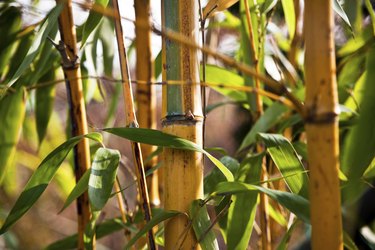
Bamboo is a beautiful and versatile plant, frequently used to create natural fences or windbreaks. It is also used as an ornamental. Unfortunately, this wild beauty is notoriously difficult to get rid of when you don't want it. Clumping bamboo plants don't spread far and are easy to remove. Simply dig up the root ball to effectively eliminate the plant. This is done by hand when dealing with a few plants, or with a backhoe if the unwanted grove is large.
Running bamboo, however, spreads itself incredibly quickly and tenaciously clings to life. Eliminating it is a process that involves cutting it down, spraying it with herbicides and cutting it down again until the plant runs out of energy and dies. This process can take two to three years.
Video of the Day
Video of the Day
Step 1: Isolate Wanted Bamboo
Before removing any bamboo, it's important to know where your unwanted shoots are coming from. If you, or your neighbor, wish to keep some of your bamboo, you'll have to separate the wanted bamboo from the unwanted. To do this, dig a trench at least 18 inches deep between the bamboo you wish to keep and the bamboo you want rid of. Examine the trench carefully to make sure you've cut through all of the rhizomes joining the two sections of bamboo. Cut any rhizomes that are still attached with a saw or pruning shears. (If you don't, the herbicide you apply later in the process may travel across the rhizomes and harm the plant you or your neighbors wish to keep.) Install a vertical rhizome barrier made of plastic, metal or concrete in your trench to keep the bamboo from spreading into unwanted areas again. To be effective, make sure your rhizome barrier sticks out about 2 inches above the soil and is at least 18 inches deep.
Step 2: Cut It Down
In late spring after the annual growth period, cut down the unwanted bamboo shoots as close to the ground as possible. A pair of pruning shears or hand saw are adequate for removing small areas of bamboo. If the unwanted grove is large, use a chainsaw to remove the bamboo quickly.
Step 3: Water and Fertilize

After cutting down your unwanted bamboo, water it and fertilize it with a nitrogen-rich fertilizer (25-4-2 or 16-4-8). This seems counterintuitive, but the most effective way to kill bamboo is to cut it down again and again until it eventually dies. The goal is to force the plant to continually work at rebuilding itself until it expends all of its energy and expires. Nitrogen-rich fertilizer also promotes the growth of leaves, which absorb the few pesticides that affect bamboo.
Step 4: Apply an Herbicide
Let the bamboo grow until it reaches a height of about 3 feet. At this height, the bamboo will be green and leafy. Use a garden sprayer to prepare a 5 percent glyphosate or 1 percent imazapyr solution. Once you've prepared it, apply the herbicide to the plant's leaves. These two herbicides are the most effective on bamboo, and other chemicals are not recommended.
Step 5: Cut It Down Again
Give your herbicide seven to 10 days to work, then cut the bamboo down again. You can use your lawn mower if it's up to the job. If not, use your chainsaw or pruning shears. After cutting the bamboo again, water and fertilize it as you did before, and wait for new, leafy growth to appear before applying more herbicide and cutting it down again. You will need to repeat this process many times, possibly through two or three growing seasons.